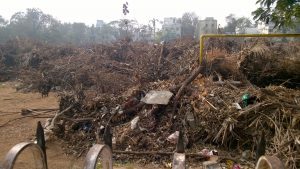D for December. D for disaster. Two years in a row, the last month of the year has brought a Doomsday-like experience for Tamil Nadu. While the ravages of the 2015 floods remain unmatched, in 2016, Cyclone Vardah left behind its own trail of destruction, which the city is still trying to cope with. The city came to a standstill for 4-5 days without electricity and water supply to many areas, and it took all the resilience and spirit of Chennaiites to get it back on its feet.
As the cyclone passed, one fact became increasingly evident: the biggest brunt had been borne by the green cover in the city. According to one report, at least 100,000 trees, comprising about a fourth of the city’s tree cover, had been uprooted by the cyclone. This created an unprecedented spike in the volume of garbage in the form of debris, branches and garden waste. This, coupled with piles of regular waste from households and commercial establishments, has created a huge challenge before the municipal authorities.
According to a press release issued by the Greater Chennai Corporation (GCC) on December 22nd, Cyclone Vardah generated 1,24,240.29 tonnes of garbage, which comprised of 65,489.18 tonnes green waste and 58,751.11 assorted garbage.
As the city grappled with the mammoth mounds of waste, the Corporation released a list of 54 places (which include the playgrounds, vacant lands and parks in the city) for educational institutions, landowners and private establishments to dispose of the green remains. In addition, separate grounds were allotted for residents to dump their waste.
Citizen woes
Not all, however, has been going smoothly.
“I live in Bharathi Avenue in Kottur, many trees were uprooted by the cyclone in my locality. When we contacted the conservancy workers, asking them to help remove the remains of the trees, they abruptly sent us off, saying they cannot help us because the avenue is located in the interiors, and they have been asked to focus on clearing the main roads. We aren’t able to tolerate the smell now and are afraid of disease outbreak,” commented Kumudha, a housewife.
“The garbage that was lying in Canal Bank Road caught fire, the reason remains unknown and I am glad it did not affect any of the hutments. What caught my attention was the fact that the garbage was burning for two hours and the fire engine reached the locality a little late,” says Mani, an auto driver.
The Somasundaram ground in T Nagar (Zone X) is surrounded by several residential buildings, schools, corporate offices and four eateries. A big challenge is that household waste is now mixed with green waste, causing a health hazard. The waste from Panagal Park and nearby areas is unloaded in the ground and all the four eateries in the locality have been facing a housefly menace post cyclone. “Our sales is dipping due to the unhygienic surroundings. If any complaint is filed, we have to pay them to take the issue forward, which we cannot afford to,” rues Mani, owner of one of the eateries.
The space behind the Kotturpuram station (Zone XIII) is another place where the waste collected from the area is dumped, which is subsequently disposed of in Kodungaiyur and Perungudi dumping grounds by private contractors, toiling round the clock.
“We do not have any working hours now. Since the cyclone has caused severe damage, we have started to work early in the morning and go on late into the evening. In addition, I’m also scared for my health, the green waste emanates such a stink but I have no other choice but to work. We unload the green waste from Korattur at Perungudi 8-9 times a day,” says Gandhi of Laawin Enterprises, a private contractor.
One of the worst affected areas in the city is Anna Main Road in MGR Nagar. The junk is literally seen overflowing onto the roads, and traffic is in a mess.
“We encounter problems since the morning due to dumping of waste on the main road. The flies do not go away even after spraying repellents. I see an employee from the Health department spraying time and again, but all his efforts are in vain. Amma canteen, ration shops, residential spaces are all close by and moreover this is a main thoroughfare: the garbage would affect every single passer-by. Even after seeing media reports, the corporation has not started taking the issue seriously,” says Raja, a resident of MGR Nagar.
Clearance plans
On December 30th, Mr Balasubramanian, Assistant Executive Engineer, Solid Waste Management Department of GCC, told this reporter, “The clearance would take another 7-10 days; to make it faster we have also handed zones 9, 10 and 13 to private contractors and the work has been completed. The green waste collected would be converted to energy, while the non-biodegradable waste separated from the chunk would be used for laying roads in the city.”
However, no further details or updates were available on how the authorities propose to convert the green waste to energy. Questions also remain over how they propose to segregate the green waste after they have been dumped at the Kodungaiyur and Perungudi landfill sites, where mixed waste is rampant. Repeated attempts by Citizen Matters Chennai to contact the official and obtain clarifications on the above proved futile.
Meanwhile, it has been over 10 days since the Assistant Executive Engineer’s assurance, and large quantities of green waste are still to be seen at various open spaces, gardens and playgrounds around the city. With the rains having gone away completely, the dry foliage is a real fire hazard. Just five days ago, a thick haze hung over the Adyar river at Kotturpuram bridge, caused by a fire in the tree waste dumped at Boat Club. Clearly, Chennaiites are not going to get a respite from the Vardah effect, just yet.

